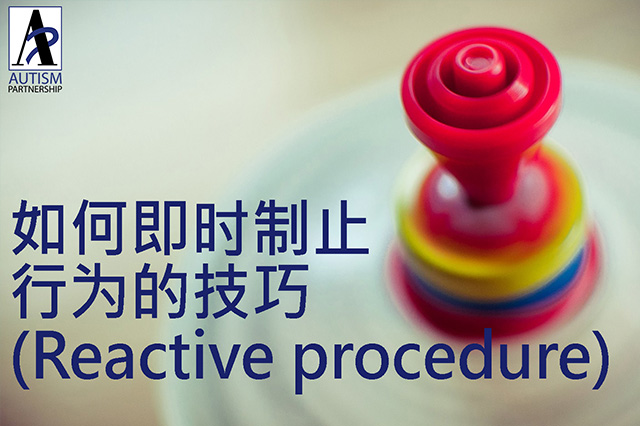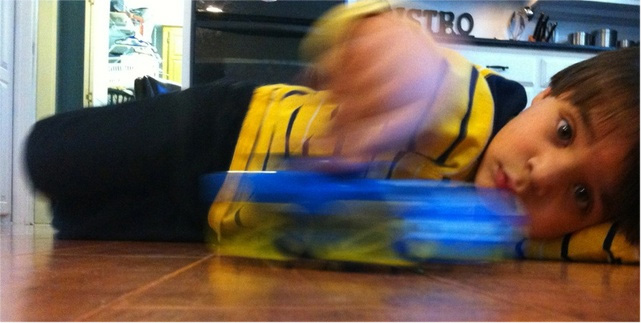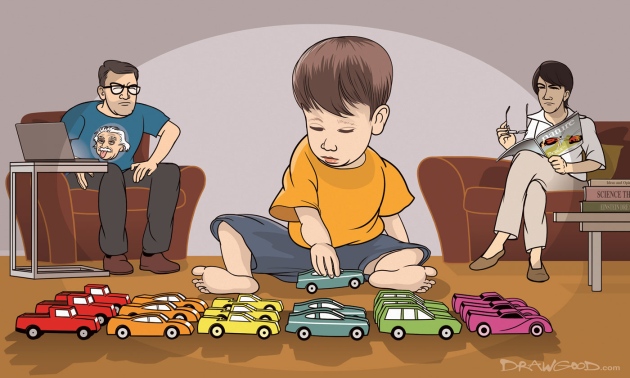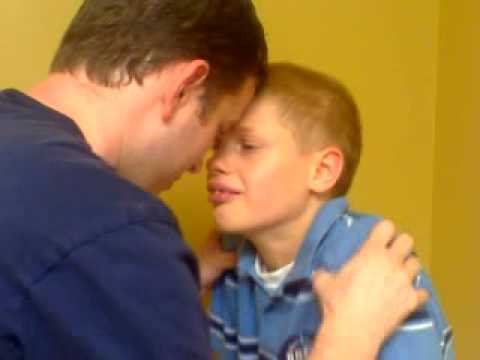
Fixed interest and repetitive behaviour are some of the clinical diagnostic criteria for autism spectrum disorder. Self-stimulating behaviour is an example of repetitive behaviour, which is broadly divided into three types:

3. Exhibiting obsessive habits, such as : insisting on wearing clothes of a fixed colour, the way of holding objects, arranging objects, sticking to a regular routine (even insisting on performing each procedure by him/herself), repeating the same topic, and so on.

We often hear parents in their daily lives dealing with these behaviors by scolding, ignoring the child, using punishment as well as other methods. The effect of the child ceasing such behaviors is not significant, and in some cases, there are signs of increased frequency and even deterioration of the situation. The reason is simple: these acts are intended to obtain sensory stimulation and it is very rewarding for the child when achieved. Therefore, using an ineffective strategy only allows for the indulgence of these inappropriate behaviors.
Our Director, Toby Mountjoy had shared with parents, during the question and answer session, about teaching replacement techniques to intervene in the child’s self-stimulating behaviour (Proactive Procedure). In the long run, teaching alternative skills is an effective way to improve the problem. However, when the child’s self-stimulatory behavior is very frequent, it might be challenging to start teaching any skills, so here are some ways to interrupt the behavior (Reactive Procedure).
First of all, you need to know that it’s not possible for the child to get rid of these behaviors right from the start, especially in the early stages of the intervention. So it would be good for you to set aside some time every day (e.g. 15-20 minutes) in order to practice with your child.
Step 1: Whenever the child self-stimulates, you may have to touch part of the child’s body, or even the whole body, to interrupt the child’s behavior.(e.g. gently put the child’s hands down if they exhibiting hand flapping behavior).

The purpose is to immediately eliminate the sensory pleasure the child obtains through these acts, therefore, the sooner the behavior is stopped, the lesser time the child gets the pleasure. If possible, parents should provide the least amount of physical action / assistance to stop the behavior, because we want the child to start learning to practise self-restraint. This way, in the future, interrupting the behavior can be relatively faster and easier. If the child uses an object to get sensory stimulation (e.g. spinning of a cup), simply just remove the object.
Step 2: Use incentives to encourage your child to exercise restraint. Parents who are familiar with the use of tokens with their children can use tokens to exchange for rewards. Otherwise, parents can hold onto the reward (e.g. the child’s favourite snack, tablet PC, etc.).
Typically in the early stages of the intervention, the amount of time the child can exercise restraint is very short. Therefore, parents have to seize the correct opportunity to reward the process quickly and directly.

While delivering the reward, also praise the child in simple and concise language, so that the child knows the expectations of the appropriate behavior, such as: “Good hands, quiet”. This will help the child in learning the relationship between demonstrating self-control from exhibiting self-stimulatory behaviour and getting the reward.
Step 3: As your child begins to learn to regulate his own behaviour, you can gradually incorporate the teaching of alternative skills or other courses. Suppose I want to teach the child to play puzzles to replace his hand-flapping behavior, I will gradually ease in the teaching of puzzle play with the training of self-control.
For example, the child has to collect six tokens in order to be rewarded, so for the first 3-4 tokens, they would be given an opportunity to demonstrate self-control (i.e. refraining from self-stimulation) and then for the rest of the tokens, they would be given a puzzle so that they can demonstrate appropriate play with the puzzle.

Tokens are given when the child completes the instruction of fixing the puzzle and expressing self-control at the same time. Parents can adjust the number of tokens in response to the child’s performance. Playing the puzzle becomes the replacement skill for hand-flapping.
When the child understands the behaviour they need to control, the time in which they abstain from self-stimulatory behavior should increase, and so the amount of time the parents can work with the child and the expectations of the appropriate behaviors would greatly increase too.
Self- stimulatory behaviours greatly affect student’s learning process. These disruptive behaviors that interfere with the learning process can be addressed in a 1:1 setting with intensive practice opportunities.
Ms. Christy Lai is a Board Certified Behavior Analyst with a Master of Science in Applied Behavior Analysis from St. Cloud State University and a Bachelor of Arts in Psychology from the University of Michigan, Ann Arbor. Ms. Lai joined Autism Partnership (AP) in 2011 and she has extensive experience in working with children with ASD. Ms. Christy Lai currently take lead of the case supervision in the new established AP Beijing center. At the same time, she oversees the Little Learners program in Hong Kong and Shanghai and consults families in Asia. She directs overseas training to staff in the Train the Trainer program and provides parent education to families with children with ASD. She also conducts Jumpstart and PIIP programs locally and internationally. In additions, she is keen to take part in overseas ASD conferences and take lead of the design and production of AP teaching materials. Moreover, she helps with producing ABA training videos and articles in the APSPARKS website for public education.

Every little life is a special present for a family. From the time a baby is born, parents journey through lots of highs and lows, wishing for their child to grow up with a big smile, make great friends, find their own way in a job they love, and create a happy family. However, for […]

Parenthood is a journey filled with unexpected twists and turns, challenges, and moments of profound joy. For Adam’s father, the discovery that his son, Adam, was on the autism spectrum marked the beginning of a unique chapter in their lives. This is the story of a father’s realization, acceptance, and the unconditional love and strength […]

Autism Spectrum disorder can be diagnosed as early as 18 months. Research shows strong evidence on how effective Applied Behavior Analysis (ABA) can help children with Autism. It helps to deal with children’s challenging behaviors such as inattention, aggression, self-stimulation, etc. Howard, et al (2005) conducted a study to compare the effectiveness of 3 treatment […]
Please share to let more people learn about ASD and ABA therapy:
AP holds the belief that with quality Autism Partnership Method (APM) treatment, individuals with autism should reach their fullest potential and achieve the greatest degree of independence and highest quality of life possible.

Sign up now to get ABA and Autism related news delivered to your inbox. Enter your email to get started
Hong Kong Center
Kowloon Center

All information received will always remain confidential. We will contact you as soon as we review your message. Thanks